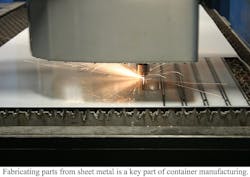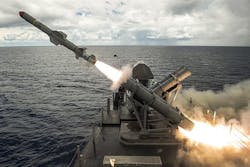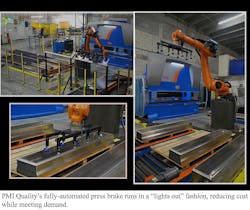Automated processes drive down costs, increase precision of critical military and aerospace packaging
Automation from manufacture through assembly and coating helps meet growing needs for rugged, protective, and precise military and aerospace shipping and transport containers.
By Del Williams for Precision Metal Industries (PMI)
When military equipment such as computer systems, radio and communications gear, weapons, ammunition, ordinance, missiles, and more are shipped or stored, special containers are needed to keep the mission- and safety-critical contents secure, prevent damage, and ensure they are ready when needed, anywhere around the world.
Systems often require protection from shock, vibration, temperature, moisture, pressure, dust, and other environmental intrusions, which can compromise sensitive components or electronics as well as function. Other factors such as portability, weight, and ease of deployment also come into play.
As a result, defense contractors frequently need specialized containers manufactured in volume at the highest levels of quality, customized for the application, often with environmental seals or sophisticated control systems. Consequently, they need suppliers they can rely on.
Today this often involves utilizing contractors with highly automated, robotic manufacturing capabilities able to do most of the work and testing in-house, given that traditional manual manufacturing techniques can be slow and introduce human error.
As such, some contractors can produce at high volume with the utmost repeatability in an essentially “lights out” fashion. The upside of this approach is that such automated processes not only increase precision and reliability, but also reduce cost while meeting demand.
Optimizing container manufacturing
Manufacturing military and aerospace shipping and storage containers can be a complex process, much more so than putting together a simple shipping crate.
For instance, manufacturing a missile container can involve cutting sheet metal to the right sizes, embossing it with a punch press, forming it into the right shapes, cleaning and welding it, followed by coating, and then assembly of various components.
Missile containers are actually quite complex, and involve a wide range of components, according to Gregory S. Wilson, Jr., vice president and general manager of Precision Metal Industries (PMI), a Pompano Beach, Florida-based sheet metal and precision machining contract manufacturer that has fabricated tens of thousands of missile containers for the U.S. military. Based on its experience with one of the leading defense contractors in the country, the company is configured to run on an automated, 24/7 basis with capacity to produce more than 500 military containers each month.
According to Wilson, missile containers are complex, multi-faceted assemblies. In fact, these containers typically include a custom container cover, container base, external fastening devices, lifting handles, missile suspension system (cradle, missile latches, and shock isolators), environmental seal, desiccant bags, pressure gauge, and manual and automatic pressure relief mechanisms (to equalize internal pressure during changes in atmospheric pressure).
Because fabricating parts from sheet metal is a key part of container manufacturing for such applications, working with a contractor that can automate much of the process has significant benefits compared to less precise, more labor-intensive manual processes.
“Sheet metal cutting can range from cutting by hand with tin snips to computer controlled laser cutting,” Wilson says. “Yet small errors in cut sizes can create big problems in the assembled product.”
Similarly, the bending process is extremely difficult with sheet metal considering that bending is highly sensitive to small changes in the geometry of the metal part. If planning is not done correctly, even small flaws in manual bending or material placement can lead to large errors when the bending process is complete.
Since proper welding of critical components is also essential to ensure the safe operation of a finished product, welds that are improperly completed – whether through human variability, inexperience, or improper technique – can also cause a failure in the manufactured part.
Instead, working with a subcontractor that can automate many of the processes in manufacturing military containers is often a more effective alternative with numerous benefits.
Lasers, robots, and pressurized missile containers
“Custom automated laser cutting is among the most effective processes for cutting plate or sheet metal for fabrication,” says Wilson. “The technology allows cutting precise, accurate geometric shapes, no matter how irregular or unusual they may be. Once programmed, it requires zero set-up time and allows unattended ‘lights out’ processing for efficient longer runs on a 24/7 basis that can expedite production and lower cost.”
In the same vein, advanced CNC (Computer Numerical Control) press brakes can help to ensure precision bending and forming, with software minimizing set-up and lead times. CNC allows for very close control of positioning, velocity, coordination, feed rates, and other precision aspects of the manufacturing process for a particular part or object.
As an example, PMI follows such an approach, which includes very precise, fully automated robotic bending and forming that can be done in an efficient, lights out fashion with minimal labor, set-up, and lead times. This can involve unique tools such as CNC press brakes to create U bends, V bends, and custom forms from flat metal sheets, as well as folding. With off-line programming software capability, once set-up is done, such equipment eliminates human variability, and ensures a repeatable, reliable process.
Automated robotic welding, with a robotic welder positioned in a specially configured cell, can also perform with extreme consistency, repeatedly producing perfect welds in the most efficient way. The precision of robotic welding makes both the process and final product very neat with little splattering and controlled seams. Such welding minimizes human error, improves reliability, and maximizes yields, which reduces cost.
In the case of PMI, for instance, thorough testing is also done as part of the production process. This includes the use of certified pressure-monitoring equipment to ensure that the latched, pressurized missile containers meet strict specifications.
To guarantee proper fit and function, the contract manufacturer also uses Government Furnished Property (GFP), such as fit check tools with the correct dimensions, to test fit 100 percent of missile shipping and storage containers. The company exceeds the requirements specified in ISO 9001 for quality in military or commercial applications, and is registered for ITAR (International Traffic in Arms Regulations).
While such manufacturing automation and testing capability has been available in larger contractors, some smaller contractors like PMI have taken it a step further by making it available along with finishing and assembly.
For instance, the contractor has an automated coating production line, capable of cleaning, pretreating, and coating to all relevant MIL-SPECs, including CARC (Chemical Agent Resistant Coating).
Wilson says the ability to complete all this work in-house streamlines the manufacturing and oversight process, since it minimizes the number of contractors involved, speeds delivery, and ensures the work is done to all required specifications.
“The U.S. armed forces have traditionally been very selective in its choice of suppliers,” says Wilson. “When it comes to the military containers required to ship and store sensitive or critical equipment, defense contractors are best served by those that are able to offer advanced, automated manufacturing and finishing with an emphasis on quality.”
About the author
Del Williams is a technical writer based in Torrance, California. He writes about health, business, technology, and educational issues, and has an M.A. in English from C.S.U. Dominguez Hills.
Search the Aerospace & Defense Buyer's Guide
The go-to resource for Intelligent Aerospace technology news & information:
Covering key topics
Across all market segments
Subscribe to the free Intelligent Inbox e-newsletter
Subscribe to receive all the latest aerospace technology news & information, delivered directly to your e-mail inbox twice a week (Tuesdays and Thursdays). Sign upfor your free subscription to the Intelligent Inbox e-newsletter at http://www.intelligent-aerospace.com/subscribe.html.
Connect on social media
Keep pace with aerospace innovation and opportunities via your favorite social media channels. Connect with Intelligent Aerospace on Twitter (@IntelligentAero), LinkedIn,Google+, and Instagram.




